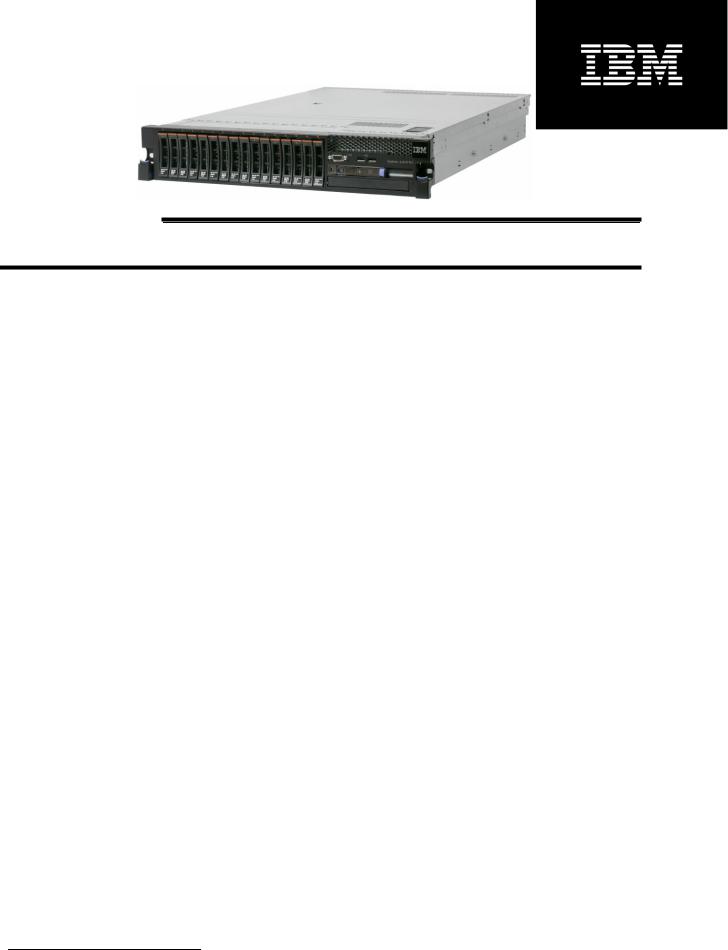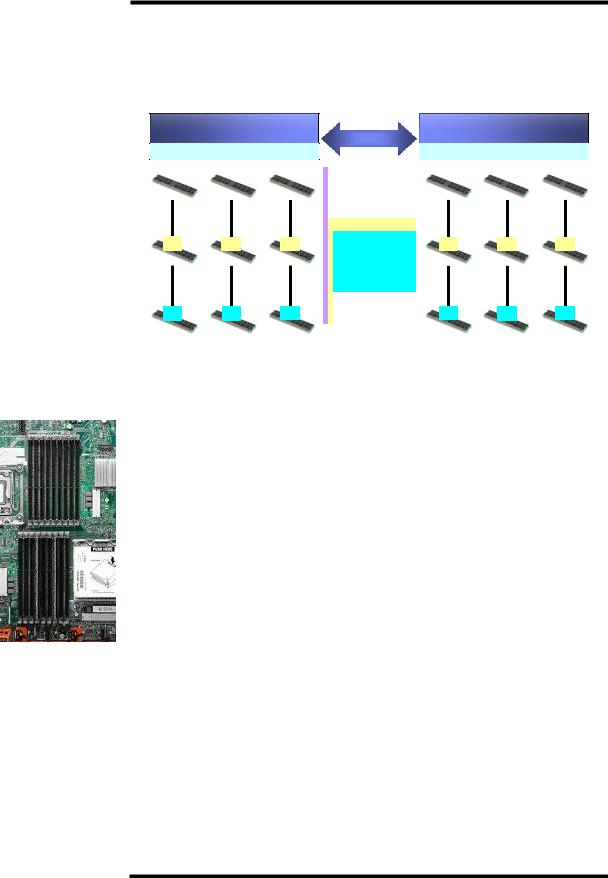IBM X3650 User Manual

Leadership enterprise server with significantly lower cost of ownership in a highly available and expandable, rack-dense, 2U dual-socket server
Product Guide
March 2010
IBM System x3650 M3
Product Overview |
Business-critical 2U server packed with innovation |
CONTENTS
Product Overview
Selling Features
Key Features
Key Options
x3650 M3 Images
x3650 M3 Specifications
The Bottom Line
Server Comparison
For More Information
Legal Information
Suggested Uses: All sectors requiring highly available, energy-efficient, rack-optimized solution for physical and virtual intensive commercial environments like eBusiness/eCommerce, collaboration, virtualization, database, and enterprise resource planning applications.
Your challenge is to do more with less—serve more Web pages, handle more secure
1connections, support more e-mail users. You need to reduce the costs of doing business and improve the service you deliver to your customers while lowering your overall risk. The dual-
2socket IBM® System x3650 M3 can reduce your costs with its new energy-smart design. It can
improve service with reduced operational complexity and increased management functionality. It
4will lower your IT risk with the resiliency that comes from no single point of failure. And like all
14IBM servers, the x3650 M3 offers you the trust that comes from the IBM global reach, service and support.
15The x3650 M3 is a game-changing rack server that uses significantly less power than previous
16generations, with unified systems management tools, leadership reliability, availability, serviceability features and broad system flexibility, housed in a compact 2U mechanical package.
19The x3650 M3 features Intel® Xeon® 5600 Series 6-core and 4-core, and 5500 Series 4-core
20and 2-core processors, with up to 12MB of shared L3 cache, to provide you with the computing power you need to match your business needs and growth. The new line of Intel processors
21delivers unprecedented intelligent performance with features like adaptive performance for
21applications and environments, Turbo Boost Technology and Hyper-Threading Technology, and integrated power gates and automated power management.
The x3650 M3 supports up to 18 DIMMs / 192GB1 of RDIMM 1333MHz DDR3 memory (or up to 12 DIMMs / 48GB of UDIMM memory) and provides Chipkill™ ECC (Error Checking and Correcting) protection—for high performance and reliability. For even higher levels of availability,
the x3650 M3 also offers memory mirroring. Up to 4 integrated high-speed Gigabit Ethernet controllers are available (offering TOE (TCP Offload Engine) support on Microsoft® Windows®), as are four high-performance adapter slots (PCIe x8). The x3650 M3 offers an optional embedded hypervisor to manage your virtual workloads.
The System x3650 M3 supports up to 16 high-performance hot-swap HDDs with an internal storage capacity of 8.0TB (2.5-inch hot-swap Serial-Attached SCSI (SAS) or Serial-Attached ATA (SATA) drives). Alternatively, up to 16 solid-state drives (SSDs) are also available to keep power low, improve resiliency, and offer up to 800GB of storage. To address your backup needs,
up to eight HDDs or SSDs and one internal tape drive or removable disk cartridge drive can be used. The server includes a choice of several IBM ServeRAID® storage controllers that provide broad levels of hardware-based RAID solutions. The ultra-dense 2U form factor allows businesses to increase their computing power and spread their workload without outgrowing their current data center. Up to 21 of these 2U servers can be installed in a single 42U rack, for a total of up to 42 processors and 252 processor cores, offering tremendous deployment flexibility.
Standard in the x3650 M3 is the Integrated Management Module (IMM) that enables the user to manage and control the server easily—both locally and remotely. In conjunction with the IMM, the x3650 M3 comes with a Bosch BMP085 altitude sensor (altimeter) that governs fan rotation based on altitude, to help lower your energy consumption. The IMM offers a high level of manageability that is designed to keep costs down and the system up—even when network usage increases. IBM’s innovative pop-out/drop-down light path diagnostics panel enables quick servicing of the system if a problem develops. These advanced features help maximize network availability by increasing uptime, as do hot-swap solid-state drives; hot-
swap/redundant SAS or SATA HDDs, redundant ultra-efficient power supplies and fan modules; Active Memory™; integrated RAID; temperature-controlled fans with Calibrated Vectored Cooling™; IPMI 2.0 support, including highly secure remote power control and
1 192GB of RDIMM or 48GB of UDIMM memory supported when 16GB RDIMMs and 4GB UDIMMs are available in 2Q/2010.
1
Please see the Legal Information section for important notices and information.

Leadership enterprise server with significantly lower cost of ownership in a highly available and expandable, rack-dense, 2U dual-socket server
|
Serial over LAN; as well as text-console redirect over LAN. |
|
Another improvement with the new generation of X-Architecture is the replacement of old BIOS |
|
with a new generation United Extensible Firmware Interface (UEFI). UEFI provides a more |
|
intuitive user interface and understandable event logs and better management. |
|
With the inclusion of unique IBM service and support features such as the IMM, light path |
|
diagnostics, IBM Systems Director 6.1, IBM Systems Director Active Energy Manager™, IBM |
|
ServerGuide™ and support for the optional Virtual Media Key for remote presence capability, the |
|
x3650 M3 is designed for superior uptime. |
|
If you need highly manageable, dual-socket/multi-core computing power in a rack-dense |
|
package, the x3650 M3 is the ideal system. |
|
|
Selling Features |
Price/Performance |
|
The x3650 M3 offers numerous features to boost performance and reduce costs: |
|
• Up to two 6-core or 4-core Xeon 5600 Series or 4-core Xeon 5500 Series processors and |
|
12MB or 4MB of cache per processor, offer superior performance capable of tackling the |
|
toughest jobs. 64-bit extensions provide the flexibility to run 32-bit and 64-bit applications |
|
concurrently. Xeon 5600 series processors offer up to 43% better performance than the |
|
previous-generation 5500 series processors (depending on workload). For an even lower |
|
entry price, a 2-core 5500 Series processor is available via CTO. |
|
• Low-voltage processors draw less energy and produce less waste heat than high-voltage |
|
processors, thus helping to reduce data center energy costs. Selected 4-core Xeon 5600 |
|
Series processors use only 40W and selected 6-core processors consume only 60W. This is |
|
less than half the wattage consumed by 130W processors. |
|
• Eighteen DIMMs of ultra-fast registered 1333MHz DDR3 ECC memory with Chipkill2 |
|
protection (optional) provide speed, high availability, and a memory capacity of up 192GB. |
|
• x3650 M3 servers using the L5640 and X56xx processors support 2 DIMMs per channel |
|
(2DPC) at 1333MHz; those using the X55xx processors support 2DPC at 1333MHz via the |
|
special bid process. |
|
• Optional solid-state drives (SSDs) use only 2W of power per drive, vs. 9-10W for 2.5-inch |
|
HDDs. This is as much as 80% less power than a 2.5 inch HDD would use (with a |
|
corresponding reduction in heat output). |
|
• An altimeter works in conjunction with the IMM to govern fan rotation based on the readings |
|
which it delivers to save money under normal conditions because the fans do not have to |
|
spin at high speed. |
|
• Four high-speed x8 (“by 8”) PCIe Gen 2 adapter slots offer investment protection by |
|
supporting high-performance adapters, such as 10Gb Ethernet, Fibre Channel and InfiniBand |
|
cards, none of which will run in older 33MHz and 66MHz conventional PCI slots. |
|
• The integrated ServeRAID-BR10il v2 controller (model-specific) provides RAID-0/1/1E and |
|
full-duplex (bidirectional 3Gbps) data transfers for SAS/SATA/SSD drives without consuming |
|
a valuable adapter slot. Other server models include the 6Gbps ServeRAID-M1015 (RAID- |
|
0/1/10, optional 5 with Self-Encrypting Disk, or SED) or the ServeRAID-M5014 controller |
|
standard, which provide RAID-0/1/10/5/50 (optional 6/60 SED). The ServeRAID-M5014 also |
|
offers higher performance, due to 256MB of optional onboard cache and battery backup. |
|
• Up to 16 2.5-inch hot-swap SAS/SATA hard disk drives offer high-performance with high |
|
availability. SSDs offer even higher availability, with extremely high IOPS rates. |
|
• The integrated dual Gigabit Ethernet controllers with IPMI 2.0 provide high-speed network |
|
communications. Two more NICs can be added to the planar with an additional dual-port Gb |
|
Ethernet daughtercard. The TCP Offload Engine (TOE) feature offers higher performance for |
|
TCP/IP traffic, with less overhead on the system processor. |
|
• A high degree of device integration—including hot swap SAS/SATA HDDs or SSD drives, |
|
multiple hardware-based ServeRAID options, Gigabit Ethernet ports, systems management |
|
and video controllers—lowers costs and frees up valuable adapter slots. |
|
|
|
Flexibility |
|
The x3650 M3 has the ability to grow with your application requirements, thanks to |
|
• A choice of 4-core or 6-core processors with 1.86 to 3.46GHz clock rates, up to 6.4 |
|
gigatransfers per second, and 40W to 130W maximum power draw. (An additional choice, a |
|
2-core 5500 Series processor, is available via CTO.) |
|
• Up to 192GB of high-speed registered DDR3 system memory. |
|
|
2 All models require Chipkill-enabled DIMMs (provided standard) for Chipkill protection.
2
Please see the Legal Information section for important notices and information.

Leadership enterprise server with significantly lower cost of ownership in a highly available and expandable, rack-dense, 2U dual-socket server
•A choice of either standard 1.5V DIMMs, or 1.35V DIMMs that consume 10% less energy.
•Four available high-performance PCIe x8 adapter slots in all models. Optionally, riser cards supporting PCI-X/133 or PCIe x16 adapters can be exchanged for the PCIe x8 slots.
•Upgrading to the ServeRAID-M5015 controller provides 512MB of battery-backed cache to enable higher-performance hardware RAID support, and allows the x3550 M3 to offer five RAID levels standard: RAID-0/1/10/5/50 (and optionally 6/60 with SED).
•The five USB 2.0 ports (two front, two rear, one internal) are up to 40X faster3 than older USB 1.1 ports. This provides speedy access to external HDDs (non-arrayed), optical drives, tape drives, and other USB devices. Two ports are on the front of the unit and two are on the back. The internal port supports a flash drive with embedded hypervisor or an internal tape or IBM RDX removable disk storage drive.
•A choice of up to sixteen 2.5-inch hot-swap SAS/SATA HDDs or solid-state drives, or eight 2.5-inch drives and one internal tape drive, offer a variety of storage options. The SAS and SATA HDD models provide a maximum of 8.0TB of internal hot-swap storage. The x3650 M3 supports a mix of hot-swap SAS, SATA and SSD drives.
•Alternatively, direct-attach, network-attached storage (NAS), or iSCSI or Fibre Channelattached storage can be attached using IBM System Storage™ servers.
Manageability / Security
Powerful systems management features simplify local and remote management of the x3650 M3:
•The x3650 M3 includes an Integrated Management Module (IMM) to monitor server availability, perform Predictive Failure Analysis, etc., and trigger IBM Systems Director alerts. The IMM performs the functions of both the Baseboard Management Controller (BMC) of earlier systems and the Remote Supervisor Adapter II and is upgradeable to remote presence/cKVM.
•An optional Virtual Media Key provides additional systems management capabilities, including Web-based out-of-band control; virtual floppy and optical drive support; Windows “blue screen” error capture; LDAP and SSL support; and remote redirection of PCI video, text, keyboard and mouse (cKVM). And it does all this without consuming a valuable adapter slot.
•Integrated industry-standard Unified Extensible Firmware Interface (UEFI) next-generation BIOS. New capabilities include:
–Human readable event logs — no more beep codes
–Complete out-of-band coverage by the Advance Settings Utility to simplify remote setup
–A complete setup solution, allowing adapter configuration functions to be moved into UEFI
–Consistent firmware management across an entire product line
•Integrated Trusted Platform Module (TPM) 1.2 support.
•Intel Trusted Execution Technology (TXT) support for more secure processing, and industry-standard AES NI support for faster, stronger encryption (in 5600 Series processors only).
•Integrated IPMI 2.0 support alerts IBM Systems Director to anomalous environmental factors, such as voltage and thermal conditions. It also supports highly secure remote power control using data encryption.
•Text Console Redirection support allows the administrator to remotely view x3650 M3 text messages over Serial or LAN.
•IBM Systems Director 6.1x is included for proactive systems management. IBM Systems Director comes with a portfolio of tools, including IBM Systems Director Active Energy Manager, IBM Service and Support Manager, and others. In addition, IBM Systems Director offers extended systems management tools for additional server management and increased availability. When a problem is encountered, IBM Systems Director can issue administrator alerts via e-mail, pager, and other methods.
•IBM Systems Director Active Energy Manager, an IBM-exclusive, is designed to take advantage of new system power management features, by providing actual realtime energy monitoring and reporting features.
Availability and Serviceability
The System x3650 M3 provides many features to simplify serviceability and increase system uptime:
• x3650 M3 servers offer Chipkill ECC memory protection4 (when using x4 DIMMs). Chipkill
3 Data transfer rates may be less than the maximum possible.
4 Chipkill protection is supported with x4 DDR3 DIMMs, but not x8 DIMMs.
3
Please see the Legal Information section for important notices and information.

Leadership enterprise server with significantly lower cost of ownership in a highly available and expandable, rack-dense, 2U dual-socket server
memory is up to 16X better than standard ECC memory at correcting memory errors. This can help reduce downtime caused by memory errors.
• The x3650 M3 offers memory mirroring for redundancy in the event of a non-correctable memory failure
|
|
• Toolless cover removal provides easy access to upgrades and serviceable parts. Similarly, |
||
|
|
the Virtual Media Key and the ServeRAID controller can be installed and replaced without |
||
|
|
tools. This means less time (and therefore less money) spent servicing the x3650 M3. |
||
|
|
Additionally, hot-swap/redundant HDDs, fan modules and power supplies, as well as |
||
|
|
online mirrored memory, mean greater system uptime while these components are being |
||
|
|
serviced. |
||
|
|
• New toolless slides ship with the server, together with a Cable Management Arm (CMA), |
||
|
|
that allow the rack server to easily slide into place |
||
|
|
• IBM Thermal Diagnostics allows the administrator to evaluate thermal data on the server |
||
|
|
without taking the hardware offline. This can provide greater server uptime. |
||
|
|
• The drop-down light path diagnostics panel and individual light path LEDs quickly lead the |
||
|
|
technician to failed (or failing) components. This simplifies servicing, speeds up problem |
||
|
|
resolution and helps improve network availability. |
||
|
|
• Integrated 3Gbps or 6Gbps RAID controller to enhance system availability and data |
||
|
|
protection without using a PCIe slot. |
||
|
|
• IPMI 2.0 supports highly secure remote system power control using data encryption. This |
||
|
|
allows an administrator to restart a server without having to visit it in person, saving travel time |
||
|
|
and getting the server back up and running quickly and securely. It also adds new features to |
||
|
|
those provided by IPMI 1.5, including VLAN support, Serial over LAN, enhanced |
||
|
|
authentication and encryption algorithms (RMCP+ and AES) and a firmware firewall. |
||
|
|
• Altitudeand temperature-controlled fans adjust to compensate for changing thermal |
||
|
|
characteristics. At the lower speeds they draw less power and suffer less wear. Equally |
||
|
|
important in a crowded data center, temperature-controlled fans produce less ambient noise in |
||
|
|
the data center than if they were constantly running at full speed. |
||
|
|
• The three-year (parts and labor) limited onsite warranty5 helps afford you peace of mind |
||
|
|
and greater investment protection than a one-year warranty does. |
||
|
|
|
|
|
|
Key Features |
High-Performance / High-Efficiency Xeon 5600 / 5500 Processors |
||
|
|
The x3650 M3 supports up to two high-performance Intel Xeon 5600 Series or 5500 Series |
||
|
|
processors, allowing you to upgrade to a second processor as your business needs require. The |
||
|
|
x3650 M3 offers a choice of processor clock rates, memory access speeds and energy draw, |
||
|
|
including: |
||
|
|
• 130W 6-core Xeon 5600 model X5680 running at 3.33GHz, with impressive performance/watt |
||
|
|
(21.67W per core; 6.4GTps QPI speed), 12MB of L3 processor cache, 1333MHz memory |
||
|
|
access, 2 threads per core, and Intel Turbo Boost technology |
||
|
|
• 95W 6-core Xeon 5600 models X5650, X5660 or X5670 running at 2.66, 2.8 or 2.93GHz, |
||
|
|
respectively, with reduced power draw and impressive performance/watt (only 15.83W per |
||
|
|
core; 6.4GTps QPI speed), 12MB of L3 processor cache, 1333MHz memory access, 2 |
||
|
|
threads per core, and Intel Turbo Boost technology |
||
|
|
• 60W 4-core Xeon 5600 low-voltage model L5640 running at 2.26GHz, respectively, with low |
||
|
|
power draw and impressive performance/watt (only 15W per core; 5.86GTps QPI speed), and |
||
|
|
12MB of shared L3 cache, 1333MHz memory access, 2 threads per core, and Intel Turbo |
||
|
|
Boost technology |
||
|
|
• 80W 4-core Xeon 5600 models E5620, E5630, or E5640 running at 2.26, 2.53, or 2.66GHz, |
||
|
|
respectively, with reduced power draw and impressive performance/watt (20W per core; |
||
|
|
5.86GTps QPI speed), 12MB of L3 processor cache, 1066MHz memory access, 2 threads per |
||
|
|
core, and Intel Turbo Boost technology |
||
|
|
• 40W 4-core Xeon 5600 low-voltage model L5630 running at 2.13GHz, with extremely low |
||
|
|
power draw and amazing performance/watt (only 10W per core; 5.86GTps QPI speed), 12MB |
||
|
|
of L3 processor cache, 1066MHz memory access, 2 threads per core, and Intel Turbo Boost |
||
|
|
technology |
||
|
|
• 80W 4-core Xeon 5500 models E5506 or E5507 running at 2.13 or 2.26GHz, respectively, with |
||
|
|
reduced power draw and impressive performance/watt (20W per core; 4.8GTps QPI speed), |
||
|
|
4MB of L3 processor cache, and 800MHz memory access |
||
|
|
|
|
|
|
|
|
|
|
5For terms and conditions or copies of the IBM Statement of Limited Warranty, call 800-772-2227 in the U.S. In Canada call 800- 426-2255. Telephone support may be subject to additional charges. For warranties including onsite labor, a technician is sent after IBM attempts to resolve the problem remotely. International warranty service is available in any country in which this product is sold.
4
Please see the Legal Information section for important notices and information.

Leadership enterprise server with significantly lower cost of ownership in a highly available and expandable, rack-dense, 2U dual-socket server
Also available, via configure-to-order (CTO):
•130W 4-core Xeon 5600 model X5677 running at 3.46GHz, with impressive performance (32.5W per core; 6.4GTps QPI speed), 12MB of L3 processor cache, 1333MHz memory access, 2 threads per core, and Intel Turbo Boost technology
•95W 4-core Xeon 5600 model X5667 running at 3.06GHz, with reduced draw and impressive performance/watt (23.75W per core; 6.4GTps QPI speed), 12MB of L3 processor cache, 1333MHz memory access, 2 threads per core, and Intel Turbo Boost technology
•40W 4-core Xeon 5600 low-voltage model L5609 running at 1.86GHz, with extremely low power draw and amazing performance/watt (only 10W per core; 5.86GTps QPI speed), 12MB of L3 processor cache, and 1066MHz memory access
•95W 4-core Xeon 5500 models X5550, X5560, or X5570 running at 2.66, 2.8, or 293GHz, respectively, with impressive performance/watt (23.75W per core; 6.4GTps QPI speed), 8MB of L3 processor cache, 1333MHz memory access, and Intel Turbo Boost technology
•80W 4-core Xeon 5500 models E5520, E5530, or E5540 running at 2.26, 2.4, or 2.53GHz, respectively, with reduced power draw and impressive performance/watt (20W per core; 5.86GTps QPI speed), 8MB of L3 processor cache, 1066MHz memory access, and Intel Turbo Boost technology
•80W 4-core Xeon 5500 model E5504 running at 2.0GHz, with reduced power draw and impressive performance/watt (20W per core; 4.8GTps QPI speed), 4MB of L3 processor cache, and 800MHz memory access
•80W 2-core Xeon 5500 model E5503 running at 2.0GHz, with reduced power draw (40W per core; 4.8GTps QPI speed), 4MB of L3 processor cache and 800MHz memory access
With the Xeon 5500 and 5600 Series processors, Intel has diverged from its traditional Symmetric Multiprocessing (SMP) architecture to a Non-Uniform Memory Access (NUMA) architecture. The processors are connected through serial coherency links called QuickPath Interconnect (QPI). QPI is capable of 6.4, 5.6 or 4.8 GTps (gigatransfers per second), depending on the processor model.
2-core Xeon processors contain two complete processor cores; 6-core processors, similarly, contain six cores. Each 5600 Series processor contains one 256KB L2 cache per core and one 12MB L3 cache shared by all the cores. The shared cache is dynamically allocated between the cores as needed. The multiple cores appear to software as multiple physical processors. The 2- core processors offer considerably higher performance than a same-speed Xeon processor with a single core. Likewise, 4- and 6- core processors offer considerably higher performance than a same-speed Xeon processor with 2 cores.
Turbo Boost Technology increases performance by translating the temperature, power and current head room into higher frequency. It will dynamically increase by 133MHz for short and regular intervals until the upper limit is met or the maximum possible upside for the number of active cores is reached. The maximum frequency is dependent on the number of active cores.
The amount of time the processor spends in the Turbo Boost Technology state depends on the workload and operating environment, providing the performance you need, when and where you need it. For example, a 3.33GHz 6-core X5680 processor with 3-6 cores active can run the cores at 3.46GHz. With only one or two cores active, the same processor can run those cores at
3.6GHz. Similarly, a 3.46GHz 4-core X5677 processor can run at 3.6GHz or even 3.73GHz. When the inactive cores are needed again, they are dynamically turned back on and the processor frequency is adjusted accordingly.
In processors implementing Intel Hyper-Threading Technology, each core has two threads capable of running an independent process. Thus, a 6-core processor can run 12 threads concurrently.
Intelligent Power Capability powers individual processor elements on and off as needed, to reduce power draw.
Execute Disable Bit functionality can help prevent certain classes of malicious buffer overflow attacks when combined with a supporting operating system.
Intel’s Virtualization Technology (VT) integrates hardware-level virtualization hooks that allow operating system vendors to better utilize the hardware for virtualization workloads.
DDR3 Memory with Chipkill ECC Protection
The x3650 M3 ships with registered double data rate III (DDR3) memory and provides Active Memory features, including advanced Chipkill memory protection (using x4 DIMMs), for up to 16X better error correction than standard ECC memory. In addition to offering better performance than DDR-2 or fully-buffered memory, DDR3 memory also uses less energy. DDR-2 memory already offered up to 37% lower energy use than fully buffered memory. Now, a generation later, DDR3 memory is even more efficient, using 22% less energy than DDR-2 memory.
5
Please see the Legal Information section for important notices and information.

Leadership enterprise server with significantly lower cost of ownership in a highly available and expandable, rack-dense, 2U dual-socket server
slots (192GB in 12 slots, as of 2Q/2010), or up to 24GB of UDIMM (unbuffered DIMM) memory in 12 slots (48GB in 12 slots, as of 2Q/2010). The x3650 M3 also supports either standard 1.5V DIMMs, or 1.35V DIMMs that consume 10% less energy. Redesign in the architecture of the Xeon 5500 and 5600 series processors bring radical changes in the way memory works in these servers. For example, the Xeon 5500 and 5600 series processors integrate the memory controller inside the processor, resulting in two memory controllers in a 2-socket system. Each memory controller has three memory channels. Depending on the type of memory, population of memory, and processor model, the memory may be clocked at 1333MHz, 1066MHz or 800MHz.
Xeon 5500 / 5600 Processor 0
QPI
Memory Controller
Xeon 5500 / 5600 Processor 1
Memory Controller
|
CH0 |
|
CH1 |
|
CH2 |
|
|
CH0 |
|
CH1 |
|
CH2 |
|
|
|
|
|
|
|
800MHz |
|
|
|
|
|
|
|
|
13 |
|
15 |
|
17 |
|
|
14 |
|
16 |
|
18 |
|
D1 |
D4 |
D7 |
|
D10 |
D13 |
D16 |
|||||||
1066MHz
7 |
9 |
11 |
L5640 & X5600 series |
8 |
10 |
12 |
support |
||||||
|
|
|
2DPC@1333MHz |
|
|
|
D2 |
D5 |
D8 |
|
D11 |
D14 |
D17 |
X5500 series support 2DPC@1333MHz by Special Bid
1 |
3 |
5 |
1333MHz |
2 |
4 |
6 |
D3 |
D6 |
D9 |
D12 |
D15 |
D18 |
1-18: DIMM population sequence , D1-D18: DIMM slot assignments
Notes: In the example above, with two processors installed, if one DIMM per channel is to be installed, follow the numbering in light blue. For two DIMMs per channel, use blue and yellow. If only one processor is installed, only the first nine DIMM slots can be used. Adding a second processor not only doubles the amount of memory available for use, but also doubles the number of memory controllers, thus doubling the system memory bandwidth. If you add a second processor, but no additional memory for the second processor, the second processor would have to access the memory from the first processor “remotely,” resulting in longer latencies and lower performance. The latency to access remote memory is almost 75% higher than local memory access. So, the goal should be to always populate both processors with memory.
The X55xx, L5640, and X56xx processor models support up to 1333MHz memory clock speed. With new single-rank and dual-rank RDIMMs and UDIMMs, L5640 and X56xx processors support 2 DIMMs per channel (2DPC) at 1333MHz; X55xx processors can support 2DPC at 1333MHz via the special bid process, otherwise 2DPC will drop the memory access rate to 1066MHz. The E552x/E562x-and-up and L56xx models support a maximum of 1066MHz clock speed (and thus memory access rate), and the E550x models support 800MHz clock speed.
Using 1333MHz memory (where supported) versus 1066MHz offers up to 9% better performance, while 1066MHz memory produces up to 28% better performance than 800MHz memory. Xeon 5550/5600 Series processors access memory with almost 50% lower latency than the earlier 5400 Series processors. That can result in faster processing of latency-sensitive workloads.
Regardless of memory speed, the Xeon 5500/5600 platform represents a significant improvement in memory bandwidth over the previous Xeon 5400 platform. At 1333MHz, the improvement is almost 500% over the previous generation. This huge improvement is mainly due to the dual integrated memory controllers and faster DDR3 1333MHz memory. Throughput at 800MHz is 25 gigabytes per second (GBps); at 1066MHz it’s 32GBps; and at 1333MHz it’s 35GBps. This improvement translates into improved application performance and scalability.
Memory interleaving refers to how physical memory is interleaved across the physical DIMMs. A balanced system provides the best interleaving. A Xeon 5500/5600 processor-based system is balanced when all memory channels on a socket have the same amount of memory.
The 5500 and 5600 Series processors support single-, dual-, and quad-rank memory. A memory rank is simply a segment of memory that is addressed by a specific address bit.
•A typical memory DIMM description is 4GB 2Rx4 DIMM
•The 2R designator is the rank count for this particular DIMM (2R = dual-rank)
•The x4 designator is the data width of the rank
It is important to ensure that DIMMs with the appropriate number of ranks are populated in each channel for optimal performance. Whenever possible, use dual-rank DIMMs in the system. Dualrank DIMMs offer better interleaving and hence better performance than single-rank DIMMs. For
6
Please see the Legal Information section for important notices and information.

Leadership enterprise server with significantly lower cost of ownership in a highly available and expandable, rack-dense, 2U dual-socket server
with six 2GB single-rank DIMMs by 7% for SPECjbb2005. Dual-rank DIMMs are also better than quad-rank DIMMs because quad-rank DIMMs will cause the memory speed to be downclocked.
Another important guideline is to populate equivalent ranks per channel. For instance, mixing one single-rank DIMM and one dual-rank DIMM in a channel should be avoided.
Note: It is important to populate all three memory channels in each processor. The relative memory bandwidth decreases as the number of channels populated decreases. This is because the bandwidth of all the memory channels is utilized to support the capability of the processor. So, as the channels are decreased, the burden to support the requisite bandwidth is increased on the remaining channels, causing them to become a bottleneck.
RDIMMs and UDIMMs cannot be used in the same server. 1.5V and 1.35V DIMMs can be mixed; however, all DIMMs will run at 1.5V. Different brands of DIMMs should not be mixed, due to possible timing issues.
In addition to Chipkill error correction, the x3650 M3 offers an additional level of IBM Active
Memory protection: memory mirroring.
Memory mirroring works much like disk mirroring. The total memory is divided into three channels: a primary channel, a backup channel, and an unused channel. Data is written concurrently to both the primary and backup channels. If a DIMM fails in one of the DIMMs in the primary channel, it is instantly disabled and the mirrored memory in the backup channel becomes active (primary) until the failing DIMM is replaced. One-third of total memory is available for use at any one time with mirroring enabled. (Note: Due to the double writes to memory, performance is affected.) Because the third channel is disabled with mirroring active, there is no point in populating it with memory.
Mirroring is handled at the hardware level; no operating system support is required.
DDR3 memory is currently available in 2GB, 4GB and 8GB RDIMMs, or 2GB UDIMMs. (16GB RDIMMs and 4GB UDIMMs are planned for 2Q/2010.) DIMMs are installed individually (not in pairs). However, for performance reasons, in a 2-processor system, it’s best to install a DIMM per processor.
Maximum memory capacity and speed in 2-processor configurations include:
|
|
Memory |
DIMMs per |
Max. Memory |
5600 Series |
5500 Series |
|
|
|
Frequency |
Channel |
Capacity * |
|
||
|
|
|
|
|
|||
|
|
|
|
|
|
|
|
|
|
1333MHz |
1 |
48GB RDIMM |
X5650, L5640 |
X5550 and |
|
|
|
(6 DIMMs) |
24GB UDIMM |
and above |
above |
|
|
|
|
|
|
||||
|
|
|
|
|
|
|
|
|
|
|
2 |
96GB RDIMM |
X5650, L5640 |
X5550 and |
|
|
|
1333MHz |
above (via |
|
|||
|
|
(12 DIMMs) |
48GB UDIMM |
and above |
|
||
|
|
|
CTO) |
|
|||
|
|
|
|
|
|
|
|
|
|
|
|
|
|
|
|
|
|
1066MHz |
2 |
96GB RDIMM |
E5620, L5609 |
E5520 and |
|
|
|
(12 DIMMs) |
48GB UDIMM |
and above |
above |
|
|
|
|
|
|
||||
|
|
|
|
|
|
|
|
|
|
800MHz |
3 |
144GB RDIMM |
E5620, L5609, |
E5503 - E5507 |
|
|
|
(18 DIMMs) |
and above |
and above |
|
||
|
|
|
|
|
|||
|
|
|
|
|
|
|
|
|
|
800MHz |
2 |
192GB RDIMM |
E5620, L5609, |
E5503 - E5507 |
|
|
|
(12 DIMMs) |
48GB UDIMM |
and above |
and above |
|
|
|
|
|
|
||||
|
|
|
|
|
|
|
|
|
|
800MHz- |
3 |
96GB RDIMM |
E5620, L5609, |
E5503 - E5507 |
|
|
|
1333MHz |
|
||||
|
|
(12 DIMMs) |
16GB UDIMM |
and above |
and above |
|
|
|
|
(Mirroring) |
|
||||
|
|
|
|
|
|
|
|
|
|
|
|
|
|
|
|
|
|
|
|
|
|
|
|
Integrated Virtualization
All models of the x3650 M3 support a USB 2.0 Flash Key installed preloaded with VMware ESXi 4.0 ESXi is an embedded version of VMware ESX 4.0, fully contained on the flash drive and requiring no disk space—not an “ESX Lite.” Rather than management through a Service Console based on a Linux operating system, ESXi relies on aggregate management tools, including VirtualCenter, the Remote Command Line interface and the introduction of CIM for standards-based and agentless hardware monitoring.
VMware ESXi includes all the performance, scalability and compatibility features of ESX, including full VMFS support across FC SAN, iSCSI SAN, and NAS, and 4-way VSMP. Because it runs from flash memory, it’s extremely fast and ideal for diskless configurations. It also offers enhanced security, because it runs without an operating system-based console and is
7
Please see the Legal Information section for important notices and information.
